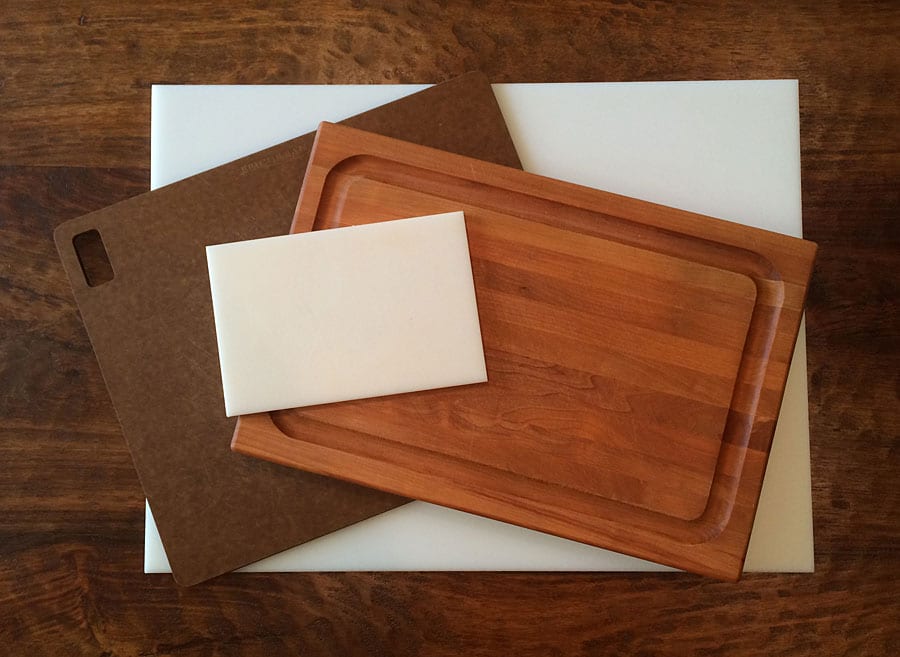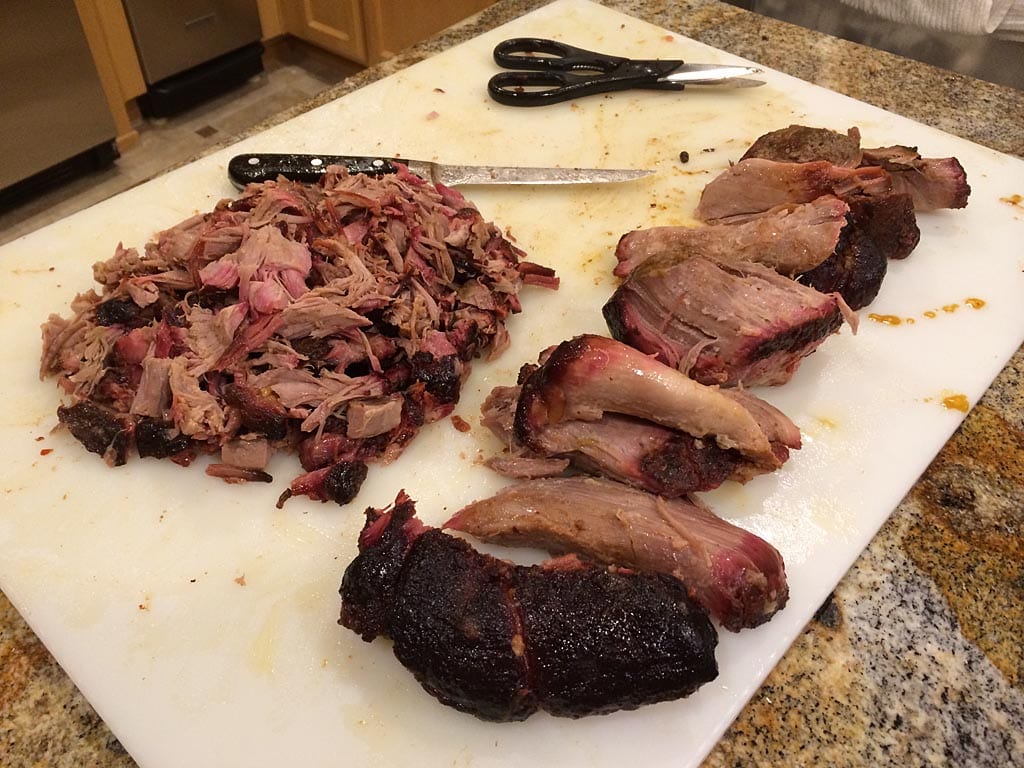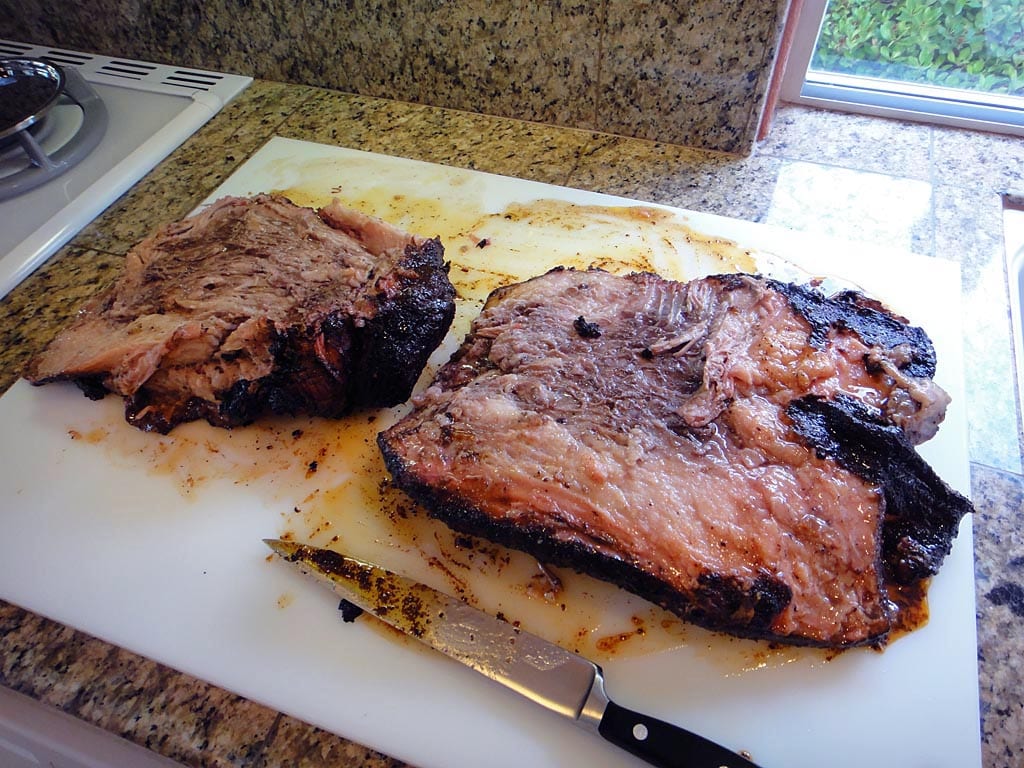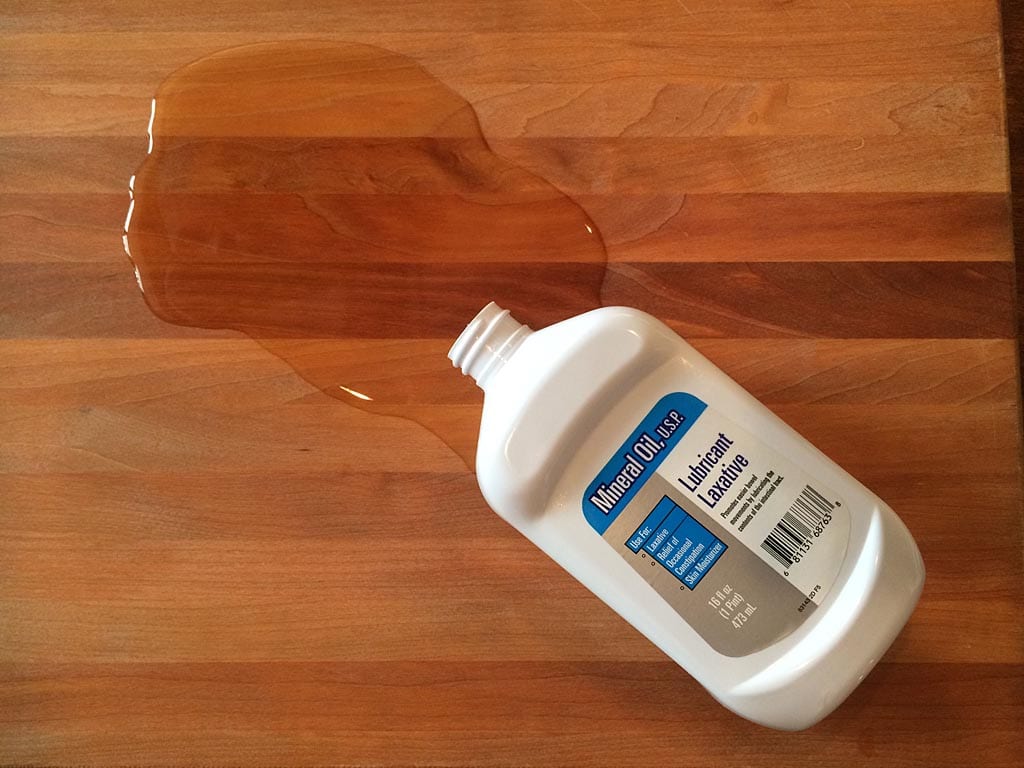In This Topic
- Board Material
- Food Safety Of Wood Vs. Plastic
- Edge Grain Vs. End Grain
- Board Size
- Carving Boards
- Cleaning
- Oiling Wooden Boards
- Preventing Boards From Slipping
- Disposable Cutting Boards
- Recommended Cutting Boards

My collection of boards: Small plastic cutting, medium wooden carving, medium compressed wood fiber cutting, large plastic cutting.
Like any other barbecue tool in your kitchen, a good cutting board is an investment. It should resist cut marks, not dull or damage your knives, should not warp, and should be easy to clean and maintain.
Board Material
Cutting boards are commonly made from wood or plastic, but also from glass, steel, and marble. Wooden boards are usually made from hardwoods, bamboo, or compressed wood fiber. Plastic boards are made from polyethylene (PE) or high-density polyethylene (HDPE).
Wood has the advantages of natural antiseptic properties and self-healing—shallow cuts in the surface tend to close on their own. Wooden cutting boards can also be a beautiful piece of kitchen equipment. However, they require regular oiling and can be heavy to lift (with the exception of compressed wood fiber boards, which are maintenance-free and lightweight).
Plastic has the advantages of being dishwasher-safe (check label to confirm) and being able to withstand cleaning with bleach or other disinfectants without soaking into the material. Plastic boards also tend to be lighter. On the downside, some plastic boards will warp over time, especially if cleaned in the dishwasher, they show cut marks more readily, and they won’t win any beauty contests in the kitchen.
Both wood and plastic tend to be easy on knife edges, while glass, steel and marble tend to damage knives because of their hardness.
Recommendation: Choose wooden or plastic cutting boards and avoid glass, steel, and marble. Lean toward wood for self-healing properties and beauty, as long as you don’t mind a little maintenance. Compressed wood fiber boards are durable, very lightweight, and virtually maintenance-free. Lean toward plastic if you value lighter boards, less maintenance, and cleaning with disinfectants or in the dishwasher.
Food Safety Of Wood Vs. Plastic
The battle over cutting board material food safety has been raging for years now, thanks to some widely published research in 1994 that found fewer harmful bacteria could be recovered from wooden boards than from plastic ones when inoculated with live bacteria in the same way. This called into question the prevailing wisdom at the time that plastic boards were the more sanitary option.
Subsequent research by Cook’s Illustrated magazine has shown that cleaning is more important than material when it comes to cutting board safety. Harmful bacteria can live as long as 60 hours on an unwashed cutting board, but washing with hot, soapy water removes almost all of the bacteria. Cook’s was able to recover an average of just 0.00015 percent of bacteria from plastic and 0.00037 percent of bacteria from wood, or fewer than 100 bacteria from each cutting board.
Recommentation: Buy whatever material you want, but clean cutting boards throughly with hot, soapy water and lots of scrubbing. Consider sanitizing with a diluted bleach solution.
Edge Grain Vs. End Grain
Most wooden cutting boards are built by gluing together small pieces of wood into large sheets, then trimming the edges and planing the top and bottom surfaces to make them smooth and level. This creates a board that is stronger and more resistant to warping than a large piece of natural, unlaminated wood.
Edge grain boards use strips of wood that run the length of the cutting board. When you use a knife on these boards, you’re cutting across the grain of the wood. End grain boards use chunks of wood placed on-end with the end grain facing up, in a sort of checkerboard pattern. When you use a knife on these boards, you’re cutting with the grain of the wood. It’s said that end grain boards show fewer cut marks and have better self-healing properties than edge grain boards, but they tend to be more expensive.
Recommendation: An edge grain wooden board is more than adequate for most applications. Choose an end grain board if you like the look and if you’re concerned about cut marks.
Board Size
 Cutting boards come in a wide range of sizes. Just as different sized knives are useful for different purposes, the same is true for cutting boards. In general, you should err on the side of larger cutting boards. There’s nothing worse than trying to carve a whole turkey or process a whole brisket on a cutting board that’s too narrow for the task. And today, the trend among professional chefs is to go with large boards measuring 18″ x 24″ for maximum work space.
Cutting boards come in a wide range of sizes. Just as different sized knives are useful for different purposes, the same is true for cutting boards. In general, you should err on the side of larger cutting boards. There’s nothing worse than trying to carve a whole turkey or process a whole brisket on a cutting board that’s too narrow for the task. And today, the trend among professional chefs is to go with large boards measuring 18″ x 24″ for maximum work space.
 A medium-sized board (14″ x 17″) is perfect for most kitchen tasks. A large board (18″ x 24″) is my go-to surface for slicing whole briskets and pulling pork butts. A small board (6″ x 9″) is great for small jobs like crushing garlic cloves.
A medium-sized board (14″ x 17″) is perfect for most kitchen tasks. A large board (18″ x 24″) is my go-to surface for slicing whole briskets and pulling pork butts. A small board (6″ x 9″) is great for small jobs like crushing garlic cloves.
I have a small plastic board that can go into the dishwasher, a medium-sized compressed wood fiber board for everyday kitchen tasks, and a large plastic board for big barbecue jobs that’s light enough to maneuver at the kitchen sink for cleaning.
Recommendation: You should have 1 medium-sized, lightweight cutting board for everyday use. You should have 1 large cutting board, probably plastic, for big barbecue tasks. Consider adding 1 small board for little jobs.
Carving Boards
Carving boards are a sub-type of cutting board with a groove around the edge that collects liquids so they don’t run off the board.
When it comes to barbecue, a carving board is particularly useful when cutting anything that gives off a lot of juices such as a whole turkey, a standing rib roast, or a tri-tip. However, in order to work, the groove has to be sufficiently deep to hold the liquid. Some carving boards have narrow, shallow grooves that hold as little as 2 ounces of liquid. Some boards have a diamond pattern on the surface that collect juice at the expense of being able to cut meat cleanly. Better carving boards will hold up to 1/2 cup of liquid in a deep, wide groove.
Remember that many carving boards are reversible and can be flipped over and used as a normal cutting board, allowing a single board to do double-duty in your kitchen.
Recommendation: You should have 1 carving board with a wide, deep groove for maximum juice collection.
Cleaning
As a general rule, wooden boards should not be cleaned in the dishwasher. An exception is compressed wood fiber boards, which are supposedly dishwasher safe. Wooden boards should not stay wet or be left to soak in water for an extended period of time, as they will warp or delaminate. Wash with hot, soapy water, rinse, and dry thoroughly. Store vertically on edge or flat.
Plastic boards can be washed in the dishwasher, if they will fit. However, some types tend to warp over time, so you may want to wash by hand. Wash with hot, soapy water, then rinse and dry thoroughly. Store vertically on edge or flat.
Cutting boards may be sanitized using a solution of 1 teaspoon bleach to 1 quart water. Apply solution to the board, let sit for 2 minutes, then wash, rinse, and dry. To remove stains, sprinkle the board with baking soda or kosher salt and scrub with a sponge and hot water. To deodorize, wipe down with white vinegar or cut lemon halves, then rinse.
Oiling Wooden Boards
 Wooden boards (with the exception of compressed wood fiber boards) should be seasoned with food-safe, USP-grade mineral oil several times a year or whenever the surface looks dry. There are name-brand oils and other expensive options out there, but mineral oil works as well as anything and is cheap, too. You’ll find it at the pharmacy…where it’s sold as a laxative. Don’t worry, you’re fine as long as you don’t drink the stuff.
Wooden boards (with the exception of compressed wood fiber boards) should be seasoned with food-safe, USP-grade mineral oil several times a year or whenever the surface looks dry. There are name-brand oils and other expensive options out there, but mineral oil works as well as anything and is cheap, too. You’ll find it at the pharmacy…where it’s sold as a laxative. Don’t worry, you’re fine as long as you don’t drink the stuff.
Apply a good amount of mineral oil using paper towels and allow it to soak into the wood for several minutes. Warming the oil just slightly before use may help it penetrate better. You can’t apply too much oil. Just keep applying until the wood won’t accept any more oil, then wipe off the excess with paper towels.
Don’t oil boards with vegetable oil or other cooking oils that can go rancid and leave your board smelling funky.
Wooden boards can be sanded to remove cut marks and stains. The process is beyond the scope of this article, but must be done carefully so as to maintain a level cutting surface.
Preventing Boards From Slipping
It’s common for cutting boards to slip and move around on the kitchen counter during use. Some boards have feet or pads to prevent this, but that makes it difficult to flip the board and use the other side. The OXO Good Grips cutting board has rubber ends that keep the board secure while still being able to use the back side.
However, a simple approach for any cutting board is to lay down a piece of non-slip cabinet shelf liner or a slightly damp dish towel, then place the cutting board on top. This will keep your board from slip-sliding away.
Disposable Cutting Boards
I’m not a big fan of disposable stuff, but I can see why folks involved with competition barbecue have made disposable cutting boards (cutting sheets, really) so popular. Lightweight, sanitary, use once and toss, no need to clean. Most competitors buy theirs from an outfit called Smoky Mountain Smokers (no relation to the Weber cooker). There’s also a good one called Stark Boards.
Recommended Cutting Boards
Here are my recommendations for good-quality cutting boards that are worth your investment.






